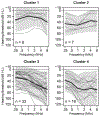A RIPOR2 in-frame deletion is a frequent and highly penetrant cause of adult-onset hearing loss
- PMID: 32631815
- PMCID: PMC8120656
- DOI: 10.1136/jmedgenet-2020-106863
A RIPOR2 in-frame deletion is a frequent and highly penetrant cause of adult-onset hearing loss
Abstract
Background: Hearing loss is one of the most prevalent disabilities worldwide, and has a significant impact on quality of life. The adult-onset type of the condition is highly heritable but the genetic causes are largely unknown, which is in contrast to childhood-onset hearing loss.
Methods: Family and cohort studies included exome sequencing and characterisation of the hearing phenotype. Ex vivo protein expression addressed the functional effect of a DNA variant.
Results: An in-frame deletion of 12 nucleotides in RIPOR2 was identified as a highly penetrant cause of adult-onset progressive hearing loss that segregated as an autosomal dominant trait in 12 families from the Netherlands. Hearing loss associated with the deletion in 63 subjects displayed variable audiometric characteristics and an average (SD) age of onset of 30.6 (14.9) years (range 0-70 years). A functional effect of the RIPOR2 variant was demonstrated by aberrant localisation of the mutant RIPOR2 in the stereocilia of cochlear hair cells and failure to rescue morphological defects in RIPOR2-deficient hair cells, in contrast to the wild-type protein. Strikingly, the RIPOR2 variant is present in 18 of 22 952 individuals not selected for hearing loss in the Southeast Netherlands.
Conclusion: Collectively, the presented data demonstrate that an inherited form of adult-onset hearing loss is relatively common, with potentially thousands of individuals at risk in the Netherlands and beyond, which makes it an attractive target for developing a (genetic) therapy.
Keywords: genetics; human genetics; molecular genetics.
© Author(s) (or their employer(s)) 2020. No commercial re-use. See rights and permissions. Published by BMJ.
Conflict of interest statement
Competing interests: None declared.
Figures





References
-
- World Health Organization. The global burden of disease: 2004 update Geneva: World Health Organization, 2008. Available: http://www.who.int/features/factfiles/global_burden/en/
-
- Sloan-Heggen CM, Bierer AO, Shearer AE, Kolbe DL, Nishimura CJ, Frees KL, Ephraim SS, Shibata SB, Booth KT, Campbell CA, Ranum PT, Weaver AE, Black-Ziegelbein EA, Wang D, Azaiez H, Smith RJH. Comprehensive genetic testing in the clinical evaluation of 1119 patients with hearing loss. Hum Genet 2016;135:441–50. - PMC - PubMed
-
- Zazo Seco C, Wesdorp M, Feenstra I, Pfundt R, Hehir-Kwa JY, Lelieveld SH, Castelein S, Gilissen C, de Wijs IJ, Admiraal RJ, Pennings RJ, Kunst HP, van de Kamp JM, Tamminga S, Houweling AC, Plomp AS, Maas SM, de Koning Gans PA, Kant SG, de Geus CM, Frints SG, Vanhoutte EK, van Dooren MF, van den Boogaard M-JH, Scheffer H, Nelen M, Kremer H, Hoefsloot L, Schraders M, Yntema HG. The diagnostic yield of whole-exome sequencing targeting a gene panel for hearing impairment in the Netherlands. Eur J Hum Genet 2017;25:308–14. - PMC - PubMed
-
- Van Camp G, Smith R. Hereditary hearing loss homepage. Available: http://hereditaryhearingloss.org/
-
- Gates GA, Couropmitree NN, Myers RH. Genetic associations in age-related hearing thresholds. Arch Otolaryngol Head Neck Surg 1999;125:654–9. - PubMed
Grants and funding
LinkOut - more resources
Full Text Sources
Other Literature Sources
Molecular Biology Databases
